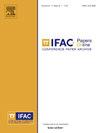Synchronization of Kuramoto oscillators via HEOL, and a discussion on AI
Q3 Engineering
引用次数: 0
Abstract
Artificial neural networks and their applications in deep learning have recently made an incursion into the field of control. Deep learning techniques in control are often related to optimal control, which relies on the Pontryagin maximum principle or the Hamilton-Jacobi-Bellman equation. They imply control schemes that are tedious to implement. We show here that the new HEOL setting, resulting from the fusion of the two established approaches, namely differential flatness and model-free control, provides a solution to control problems that is more sober in terms of computational resources. This communication is devoted to the synchronization of the popular Kuramoto’s coupled oscillators, which was already considered via artificial neural networks by L. Bttcher et al. (Nature Commun., 2022), where, contrarily to this communication, only the single control variable case is examined. One establishes the flatness of Kuramotos coupled oscillator model with multiplicative control and develops the resulting HEOL control. Unlike many examples, this system reveals singularities that are avoided by a clever generation of phase angle trajectories. The results obtained, verified in simulations, show that it is not only possible to synchronize these oscillators in finite time, and even to follow angular frequency profiles, but also to exhibit robustness concerning model mismatches. To the best of our knowledge that has never been done before. Concluding remarks advocate a viewpoint, which might be traced back to Wiener’s cybernetics: control theory belongs to AI.
利用HEOL实现Kuramoto振子的同步,并讨论AI
近年来,人工神经网络及其在深度学习中的应用已经进入了控制领域。控制中的深度学习技术通常与最优控制有关,最优控制依赖于庞特里亚金极大值原理或汉密尔顿-雅可比-贝尔曼方程。它们隐含的控制方案执行起来很繁琐。我们在这里表明,新的HEOL设置是由两种既定方法(即微分平坦度和无模型控制)的融合产生的,它为控制问题提供了一种在计算资源方面更清醒的解决方案。本通讯致力于流行的Kuramoto耦合振荡器的同步,这已经被L. Bttcher等人(Nature common)通过人工神经网络考虑过。, 2022),其中,与此通信相反,只检查单个控制变量的情况。建立了具有乘法控制的Kuramotos耦合振子模型的平整度,并给出了相应的HEOL控制。与许多例子不同的是,这个系统揭示了奇点,而奇点是通过巧妙地生成相角轨迹来避免的。仿真结果表明,不仅可以在有限时间内同步这些振荡器,甚至可以遵循角频率分布,而且还可以对模型不匹配表现出鲁棒性。据我们所知,这是前所未有的。结束语提倡一种观点,这种观点可以追溯到维纳的控制论:控制论属于人工智能。
本文章由计算机程序翻译,如有差异,请以英文原文为准。
求助全文
约1分钟内获得全文
求助全文
来源期刊

IFAC-PapersOnLine
Engineering-Control and Systems Engineering
CiteScore
1.70
自引率
0.00%
发文量
1122
期刊介绍:
All papers from IFAC meetings are published, in partnership with Elsevier, the IFAC Publisher, in theIFAC-PapersOnLine proceedings series hosted at the ScienceDirect web service. This series includes papers previously published in the IFAC website.The main features of the IFAC-PapersOnLine series are: -Online archive including papers from IFAC Symposia, Congresses, Conferences, and most Workshops. -All papers accepted at the meeting are published in PDF format - searchable and citable. -All papers published on the web site can be cited using the IFAC PapersOnLine ISSN and the individual paper DOI (Digital Object Identifier). The site is Open Access in nature - no charge is made to individuals for reading or downloading. Copyright of all papers belongs to IFAC and must be referenced if derivative journal papers are produced from the conference papers. All papers published in IFAC-PapersOnLine have undergone a peer review selection process according to the IFAC rules.
 求助内容:
求助内容: 应助结果提醒方式:
应助结果提醒方式:


